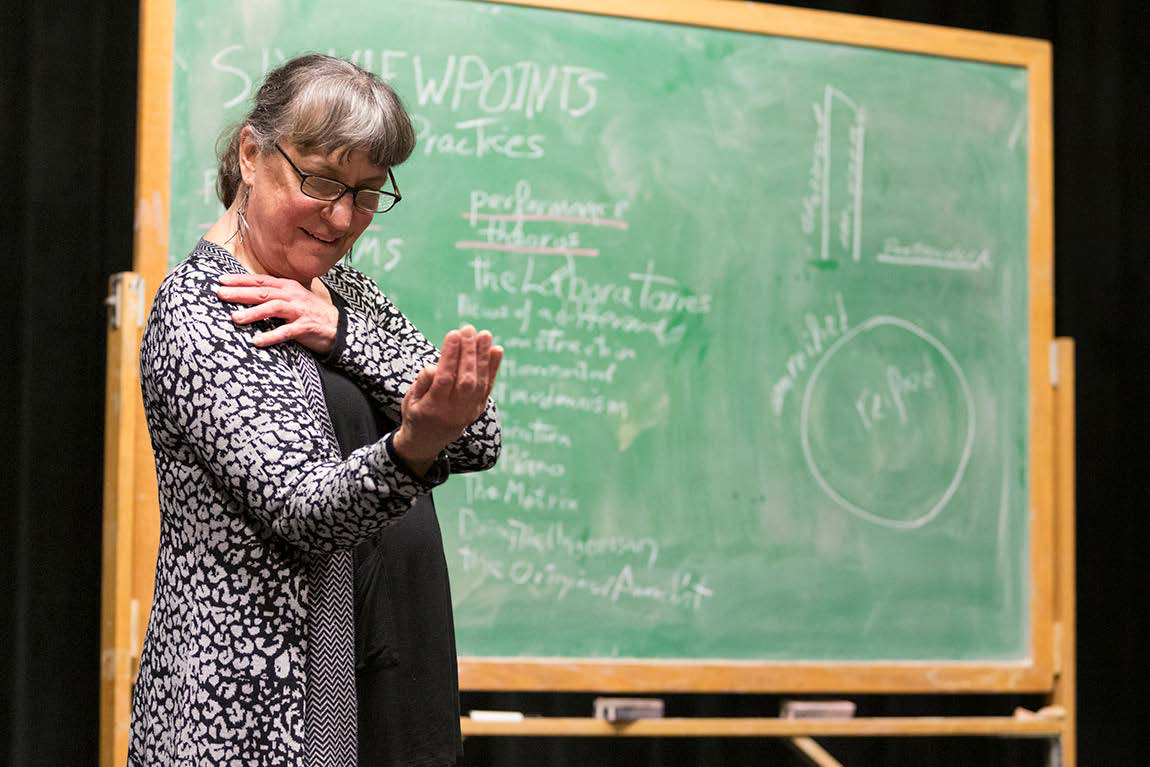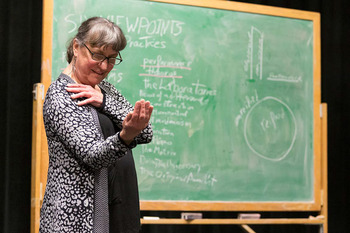Blackboard—Hand—Stone
On the day I met Mary Overlie in the summer of 2004, I sat enraptured (if befuddled) as she stood before her iconic blackboard and lectured on the approach to theatre that she originated and developed since the 1970s: The Viewpoints. On the board, she had written the names of The Viewpoints’ six materials: Space, Shape, Time, Emotion, Movement, and Story. Below them were her chalk drawings representing The Viewpoints’ foundational principles: six squares to show “solid state theatre” and its “deconstruction”; the “vertical” tower of classicism and modernism collapsing to the “horizontal” assemblage of postmodernism; and the circle of “reification,” her name for the artists’ process of moving concepts, ideas, forms, and perceptions from the unknown to the known and back again. Then, she flipped the board to reveal her drawing of “The Bridge,” with its nine supportive frames for Viewpoints study, which led from “News of a Difference” to “The Original Anarchist.”
About an hour into her lecture, Mary extended her arm to gaze inquisitively at her hand. After some time, she said, “Any moment this will become art. This is The Viewpoints.” After years of talking with Mary, writing about her, teaching The Viewpoints, and creating performances through her work, I’ve come to understand the greater significance of my friend and mentor’s simple act. For me, it speaks to who Mary Overlie was, as a Bessie Award-winning choreographer, dancer, teacher, theorist, and comrade. What she taught with that gesture was the quiet confidence she modeled for her students through her life, art, and teaching. It embodied her faith that, given attention, trust, and patience, the materials of theatre—beyond the actor’s feelings, intentions, creative ideas, or body—would become art.
Mary explained on that day in 2004 how training in The Viewpoints leads the performer to become an Original Anarchist. An Original Anarchist, which she most assuredly was, would be freed from preconceptions about performance. Like her, that performer would skim “a small, flat, round stone […] across the surface of a pond,” in order to ask “What is theatre made of?” (Overlie Reference Overlie2016:119, 127). The Viewpoints would not provide an answer to that question, but would instead prepare the performer to pose it while waiting for theatre’s material “languages” to speak. With a mischievous smile, she would say, “Let the materials teach you. They know more and have better ideas.”
Mary told us about the foundational experiences that shaped her art: growing up in Terry, Montana, where the expansive landscape awakened a life-long love of space; her unconventional introduction to the ballet barre through conceptual improvisations; and the community she found at the home of the visual artists Bob and Gennie DeWeese, eavesdropping for hours as the constant influx of guests debated the concept of “art” late into the night. She talked about “jumping a freight train” as a teenager with $50.00 and no specific destination, eventually arriving in San Francisco, where she would discover both Cunningham technique and transcendental meditation.
Mary’s experiences with space, time, and artistic experimentation prepared her for the revelatory encounter of seeing Yvonne Rainer performing with the Grand Union. For all of the Grand Union’s infamously riotous spontaneity, what riveted Mary was an extended section of a site-specific performance in which Rainer simply sat on some steps and read quietly. It was at that moment, Mary said, that she knew she would “follow this woman to the end of the earth.” She did follow Rainer—to New York City—when Barbara Dilley invited Mary to perform in The Natural History of the American Dancer—Lesser Known Species (1972), commissioned by the Whitney Museum. The dancers from that work became an improvisational collaborative of the same name, whose unique approach to developing work Mary always referred to as “inventing the wheel backwards.” Rehearsing and performing with the Natural History group provided the seeds for her emerging “obsession” in articulating a new basic vocabulary for performance that would be based, not on the dancer’s body, but on the material world in which it was situated (in Sommer Reference Sommer1980:58).
The world in which she was situated as she developed The Viewpoints was central to its conception: 1970s SoHo and its downtown community of minimalist, conceptual, and interdisciplinary artists. For Mary, the space of SoHo was inextricable from space as a material language of performance. It was a central aesthetic concern for her first major choreographic works, her “window pieces,” performed in SoHo in the shallow, 3’ x 5’ street-facing windows of the Holly Solomon Gallery (Glassed Imaginations [1976], Glassed Imaginations II [1977], and Window Pieces [1977]).

Figure 1 With her ubiquitous chalkboard, Mary Overlie waits for her hand to become art while teaching a Viewpoints workshop at the University of North Carolina at Chapel Hill in February 2017. (Photo by Alex Maness)
Mary’s work in the window spaces inspired Ron Argelander to invite her to serve as the first faculty member of the Experimental Theatre Wing at Tisch School of the Arts/NYU, where she taught for nearly four decades. And it was with Wendell Beavers, who danced with her in those spaces, that she formed the Mary Overlie Dance Company (1978-85) with Paul Langland, and Nina Martin.
As she developed The Viewpoints through her teaching at NYU, Mary was instrumental in providing spaces and communities for postmodern dance training, exchange, investigation, and performance. She cofounded both Danspace Project (at St. Mark’s Church in-the-Bowery) and The School for Movement Research & Construction (now Movement Research) in 1978. That same year Mary inaugurated the Summergarden dance series with The Figure (1978) in the sculpture garden at New York’s Museum of Modern Art. It was also the first year that the Kitchen became a space for dance performance, curated by Eric Bogosian. Bogosian, who was taking dance classes from Mary, invited her to be a part of the Kitchen’s initial dance season, where she debuted Painters Dream, with Beavers, Langland, Martin, and Mabou Mines actor David Warrilow—the first of many works at the Kitchen.
The diversity of SoHo’s performance venues yielded collaborations with other downtown artists: with the Grand Union at 112 Greene St.; with Natural History at Artists Space and Ornette Coleman’s Artists House; and with Mabou Mines, for whom she choreographed Lee Breuer’s The Saint and the Football Players on football fields at Connecticut College (1975) and Pratt (1976) and JoAnne Akalaitis’s Obie Award-winning Cascando (1976), Dressed Like an Egg (1977), and Dead End Kids (1980).
Mary spent much of the late 1980s and 1990s in Europe, where she started NYU’s ETW Paris studio and established the Pro Series (now ImPulsTanz) at the Vienna Tanzwochen festival. While she continued to choreograph and perform, she became increasingly focused on theorizing, teaching, and writing about The Viewpoints. Mary talked about this work as a conceptual art project, one that also inspired other artists and ensembles to create their own approaches to performance-making and training, most notably Anne Bogart/SITI Company’s Viewpoints and Moisés Kaufman/Tectonic Theater Project’s Moment Work.
After decades of abandoned drafts, Mary self-published her book, Standing in Space: The Six Viewpoints Theory & Practice (2016), nearly simultaneously with her first cancer diagnosis. Despite that, she felt freed from what she called the “book jail” of writing, and accepted invitations to teach around the world, including Toneelacademie in Maastricht, the Netherlands, and the Shanghai Theatre Academy. With each new dire prognosis, she would embark on another series of week-long, or even month-long teaching residencies around the world. Throughout, she continued to research, reassess, and rethink The Viewpoints and its teaching. As we discussed my own book on Mary and The Viewpoints in her final months, she emphatically announced her plan to put The Viewpoints in “the carwash” to “scrub the 1970s off them” to make them more approachable for contemporary actors.
On the day I arrived for my last visit to her home in Bozeman, Montana, she was barely able to move about. The following afternoon, she propped a large blackboard on top of her wood stove and delivered an hour-long lecture on The Viewpoints to a local choreographer. “When will this become art?” she asked. “What is theatre made of?”
I only ever saw Mary perform live twice since seeing her standing in front of the blackboard in 2004, skipping stones and waiting for her hand to become art. The first was during that same week in 2004, and the second was on 23 September 2019, one of the last times I saw her in person. We were onstage together at Danspace Project in her final work, Brain to Brain: A Celebration of the Life and Work of Mary Overlie. For the majority of that performance, my task was to observe the performance and take notes from a desk at the far up-right corner of the performance area. As the performers placed single stones on the stage, I spoke from the 1980 text of her first published writing:
The experience is witnessed, understood, followed, remembered and yet there is no nameable event that transpired. […] There are, however, some very engrossing small, odd gestures which dissolve into huge sweeps across the space and then occur again as gestures in a line. All of this may happen in an atmosphere of charged stillness. I do not feel that I have investigated and identified all the elements present in performance, but that is my constant project. (Overlie Reference Overlie1980:33-34)
The last time we spoke on the phone, Mary said, quite simply and emphatically, “I love art! I love art! I love art!” And it is her love of artists, her love of art, and her love of art as an investigation —this “constant project”—that is her lasting and unfinished legacy.



